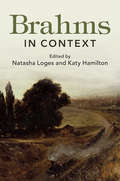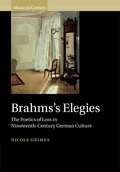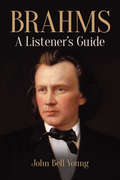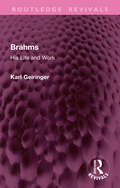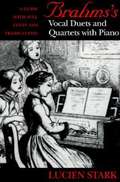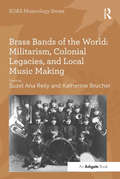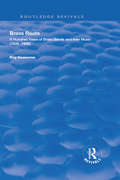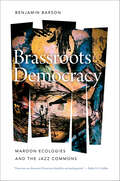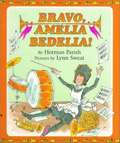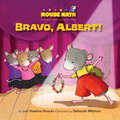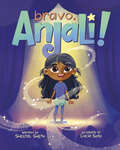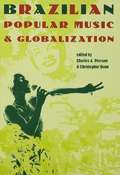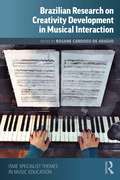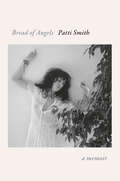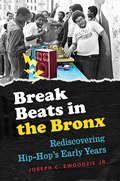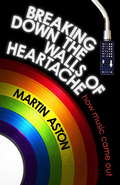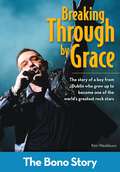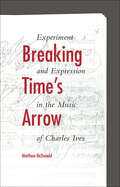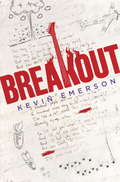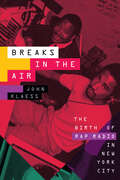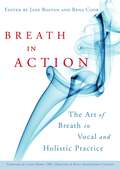- Table View
- List View
Brahms in Context (Composers in Context)
by Katy Hamilton Natasha LogesBrahms in Context offers a fresh perspective on the much-admired nineteenth-century German composer. Including thirty-nine chapters on historical, social and cultural contexts, the book brings together internationally renowned experts in music, law, science, art history and other areas, including many figures whose work is appearing in English for the first time. The essays are accessibly written, with short reading lists aimed at music students and educators. The book opens with personal topics including Brahms's Hamburg childhood, his move to Vienna, and his rich social life. It considers professional matters from finance to publishing and copyright; the musicians who shaped and transmitted his works; and the larger musical styles which influenced him. Casting the net wider, other essays embrace politics, religion, literature, philosophy, art, and science. The book closes with chapters on reception, including recordings, historical performance, his compositional legacy, and a reflection on the power of composer myths.
Brahms in the Home and the Concert Hall
by Katy Hamilton Natasha LogesJohannes Brahms was a consummate professional musician, a successful pianist, conductor, music director, editor and composer. Yet he also faithfully championed the world of private music-making, creating many works and arrangements for enjoyment in the home by amateurs. This collection explores Brahms's public and private musical identities from various angles: the original works he wrote with amateurs in mind; his approach to creating piano arrangements of not only his own, but also other composers' works; his relationships with his arrangers; the deeper symbolism and lasting legacy of private music-making in his day; and a hitherto unpublished memoir which evokes his Viennese social world. Using Brahms as their focus point, the contributors trace the overlapping worlds of public and private music-making in the nineteenth century, discussing the boundaries between the composer's professional identity and his lifelong engagement with amateur music-making.
Brahms's Elegies: The Poetics of Loss in Nineteenth-Century German Culture (Music in Context)
by Nicole GrimesNicole Grimes provides a compellingly fresh perspective on a series of Brahms's elegiac works by bringing together the disciplines of historical musicology, German studies, and cultural history. Her exploration of the expressive potential of Schicksalslied, Nänie, Gesang der Parzen, and the Vier ernste Gesänge reveals the philosophical weight of this music. She considers the German tradition of the poetics of loss that extends from the late-eighteenth-century texts by Hölderlin, Schiller and Goethe set by Brahms, and includes other philosophical and poetic works present in his library, to the mid-twentieth-century aesthetics of Adorno, who was preoccupied as much by Brahms as by their shared literary heritage. Her multifaceted focus on endings - the end of tonality, the end of the nineteenth century, and themes of loss in the music - illuminates our understanding of Brahms and lateness, and the place of Brahms in the fabric of modernist culture.
Brahms: A Listener's Guide
by John Bell Young"Elegant, thought-provoking, often outrageous but always stimulating, this book will fascinate those who know a lot about Brahms as well as those who know little." -- Stephen Hough, pianist and composer.Hailed in his lifetime as Beethoven's successor and a powerful symbol of musical classicism, Johannes Brahms was nonetheless a controversial figure in a world infatuated with the bold new directions taken by Wagner and Liszt. Today Brahms' stature is unassailable, and his works remain staples of the repertoire in each of the many genres in which he composed.This engaging survey of Brahms' music covers his major orchestral, choral, and piano music, culminating in a discussion of the ever-popular German Requiem. Author John Bell Young, a concert pianist and music critic, offers an astute commentary on many facets of the composer's life, including the attitudes of Brahms' contemporaries and his complex romantic relationships. Readers will find this volume an accessible guide to the great composer's compelling music, placed within the context of his era and environment.
Brahms: His Life and Work (Routledge Revivals)
by Karl Geiringer Irene GeiringerOriginally published in 1936, as a second edition in 1948 and as an enlarged and third edition in 1982, Karl Geiringer’s biography of Brahms is generally regarded as one of the finest studies of the composer ever published in any language. It is based on the body of material in the archives of the Viennese Society of Friends, for which Karl Geiringer was curator from 1930-1938, and which contains more than a thousand letters written by and to Brahms. These letters, exchanged with family and with his famous contemporaries, reveal his loneliness, grim humour, loyalty, painful shyness and enthusiasm for the music of Beethoven and Schubert – moods that the self-effacing composer did not like to publicly display. Divided into sections on Brahms’s solitary, scholarly existence and his fruitful composing career – including examinations of rare first drafts – the biography relates how crises in Brahm’s personal life were translated into his music, and how he often managed to ignore or suppress them.
Brahms’s Vocal Duets and Quartets with Piano: A Guide with Full Texts and Translations
by Lucien Stark"... a generous treatment of some of Brahms's most endearing and imaginative creations." --Choice"... an excellent addition to the literature on vocal chamber music... " --NotesIn this sequel to A Guide to the Solo Songs of Johannes Brahms, Lucien Stark opens up a beautiful and largely neglected repertoire, providing the full German text for each song, along with a new English translation, notes on vocal ranges, and a wealth of engaging commentary of technical, aesthetic, and historical interest.
Brass Bands of the World: Militarism Colonial Legacies And Local Music Making (SOAS Studies in Music Series)
by Katherine Brucher Suzel Ana ReilyBands structured around western wind instruments are among the most widespread instrumental ensembles in the world. Although these ensembles draw upon European military traditions that spread globally through colonialism, militarism and missionary work, local musicians have adapted the brass band prototype to their home settings, and today these ensembles are found in religious processions and funerals, military manoeuvres and parades, and popular music genres throughout the world. Based on their expertise in ethnographic and archival research, the contributors to this volume present a series of essays that examine wind band cultures from a range of disciplinary perspectives, allowing for a comparison of band cultures across geographic and historical fields. The themes addressed encompass the military heritage of band cultures; local appropriations of the military prototype; links between bands and their local communities; the spheres of local band activities and the modes of sociability within them; and the role of bands in trajectories toward professional musicianship. This book will appeal to readers with an interest in ethnomusicology, colonial and post-colonial studies, community music practices, as well as anyone who has played with or listened to their local band.
Brass Roots: A Hundred Years of Brass Bands and Their Music, 1836-1936 (Routledge Revivals)
by Roy NewsomeThis book was originally published in 1998. For most of the nineteenth and the early part of the twentieth century, the brass band was a major feature of musical life in Britain. This book surveys the hundred years from 1836 in which bands flourished, examining their origins in the village bands of the nineteenth century, the culture of banding competitions that developed and the manner in which this fostered the growth and success of bands. Roy Newsome charts the impact of social and economic change on amateur bands during this period. The influence of classical music, in particular opera, on early band music is also examined. The latter part of the book looks in detail at the original music written for brass bands by composers such as Holst, Elgar and Bliss, as well as pieces written by prominent band leaders.
Brassroots Democracy: Maroon Ecologies and the Jazz Commons
by Benjamin BarsonBrassroots Democracy recasts the birth of jazz, unearthing vibrant narratives of New Orleans musicians to reveal how early jazz was inextricably tied to the mass mobilization of freedpeople during Reconstruction and the decades that followed. Benjamin Barson presents a "music history from below," following the musicians as they built communes, performed at Civil Rights rallies, and participated in general strikes. Perhaps most importantly, Barson locates the first emancipatory revolution in the Americas—Haiti—as a nexus for cultural and political change in nineteenth-century Louisiana. In dialogue with the work of recent historians who have inverted traditional histories of Latin American and Caribbean independence by centering the influence of Haitian activists abroad, this work traces the impact of Haitian culture in New Orleans and its legacy in movements for liberation.Brassroots Democracy demonstrates how Black musicians infused participatory music practice with innovative forms of grassroots democracy. Late nineteenth-century Black brass bands and activists rehearsed these participatory models through collective performance that embodied the democratic ethos of Black Reconstruction. Termed "Brassroots Democracy," this fusion of political and musical spheres revolutionized both. Brassroots Democracy illuminates the Black Atlantic struggles that informed music-as-world-making from the Haitian Revolution through Reconstruction to the jazz revolution. The work theorizes the roots of the New Orleans brass band tradition in the social relations grown in maroon ecologies across the Americas. Their fruits contributed to the socio-sonic commons of the music we call jazz today.
Brave Surrender: Let God’s Love Rewrite Your Story
by Kim Walker-SmithKim Walker Smith's passionate performance of "How He Loves" helped transform Jesus Culture into a global worship movement. Brave Surrender is the story of how Kim journeyed from a place of shame and fear to stages around the world where she boldly proclaims the unconditional love of God. Through her own story, Kim inspires us to experience true freedom and healing with Jesus.Coming from a painful childhood, Kim struggled to believe that God could heal her heart or bring any sense from her past. Yet when faced with the choice to hand her struggles over to God and receive His love in return, everything began to change. On the other side of surrender, Kim began a journey of looking at one painful memory at a time with God and exchanging her perspective for His truth - a journey in which God rewrote her story of pain into a story of redemption and hope.If you are longing to experience God more than the shame or hurts of your past, the pressures of your present, or the fear of your future, Brave Surrender offers a soul-healing path forward. As Kim learned in her own life, the first step - and the bravest step - is letting go. Once we let go of anything that gets between us and God, we are freed to take hold of the life that truly matters. As Kim writes, "When we encounter God's love, it changes the way we see. And when we learn to see what He sees, we will never be the same again."
Bravo! (I Can Read! #13)
by Herman ParishAmelia is suppose to help the conductor, what trouble will she get into this time.
Bravo, Albert!: Patterns (Mouse Math)
by Lori Haskins HouranEach read-aloud book in the Mouse Math series focuses on a single, basic math concept and features adorable mice, Albert and Wanda, who live in a People House. Entertaining fiction stories capture kids&’ imaginations as the mice learn about numbers, shapes, sizes and more. Over 3 million copies sold worldwide!Wanda's big show is tomorrow. Rehearsals are going well, but what should the Nibblettes wear? When a costume disaster strikes, it's Albert to the rescue!Every Mouse Math title includes back matter activities that support and extend reading comprehension and math skills, plus free online activities. (Math concept: Patterns)
Bravo, Anjali! (Always Anjali #2)
by Sheetal ShethAnjali is back for an encore in this follow-up to Always Anjali! And she isn't going to let anyone make her feel bad for being good at something, especially something she loves.For Anjali, playing the tabla is something that comes naturally--she loves feeling the drum beneath her fingers and getting lost in the music. She doesn't care that some people say it's an instrument for boys. But she does care when her skills make others treat her differently. Anjali starts downplaying her talent, and even messes up on purpose. When her teacher announces a music contest, Anjali can&’t deny her dreams of playing the tabla. From actor, author, and activist Sheetal Sheth, this second book in the Anjali series is an important message about never dimming your light.
Brazilian Popular Music and Globalization
by Charles A. Perrone Christopher DunnThis collection of articles by leading scholars traces the history of Brazilian pop music through the twentieth-century.
Brazilian Popular Music: Caetano Veloso and the Regeneration of Tradition (Ashgate Popular And Folk Music Ser.)
by Lorraine LeuBrazilian Popular Music, or M‘sica Popular Brasileira (MPB), developed in the mid 1960s as a response to the re-thinking of Brazilian national identity following the establishment of the post-1964 military regime. A leading figure in MPB at this time was Caetano Veloso, and it is his music and its reception that form the focus of this book. A leader of the Tropicalist movement, Veloso sought to initiate a critical debate on Brazilian Popular Music and the political and ideological foundations which underpinned its aesthetic. Lorraine Leu examines Veloso's musical and vocal styles, revealing the ways in which they play with traditional expectations between the performer and listener, and argues that they represent an important response to the severe censorship and repression of the military regime.
Brazilian Research on Creativity Development in Musical Interaction (ISME Series in Music Education)
by Rosane Cardoso de AraújoBrazilian Research on Creativity Development in Musical Interaction focuses on creativity that involves interactive musical activities, with different groups, such as professional musicians, students, and student teachers. It seeks to present research with a theoretical foundation on musical creativity and interaction, within psychology and music pedagogy. A collection of ten contributed essays present studies that promote understanding of the possibilities of creative development from the interactive process. All are undertaken within the context of teaching and learning, whether one-on-one or group lessons, ranging from elementary school music class, instrument study, choral singing, composition and teaching an autistic student.
Bread of Angels: A Memoir
by Patti SmithA radiant new memoir from artist and writer Patti Smith, author of the National Book Award winner Just Kids&“God whispers through a crease in the wallpaper,&” writes Patti Smith in this moving account of her life. A post–World War II childhood unfolds in a condemned housing complex where we enter the child&’s world of the imagination. Smith, the captain of her loyal and beloved sibling army, vanquishes bullies, communes with the king of tortoises, and searches for sacred silver pennies.The most intimate of Smith&’s memoirs, Bread of Angels takes us through her teenage years where the first glimmers of art and romance take hold. Arthur Rimbaud and Bob Dylan emerge as creative role models as she begins to write poetry then lyrics, ultimately merging both into the songs of iconic recordings such as Horses, Wave, and Easter.She leaves it all behind to marry her one true love, Fred Sonic Smith, with whom she creates a life of devotion and adventure on a canal in St. Clair Shores, Michigan. Here, she invents a room of her own, a low table, a Persian cup, inkwell and pen, entering at dawn to write. The couple spend nights in their landlocked Chris-Craft studying nautical maps and charting new adventures as they start a family.A series of profound losses mark her life. Grief and gratitude are braided through years of caring for her children, rebuilding her life and, finally, writing again—the one constant in a life driven by artistic freedom and the power of the imagination to transform the commonplace into the magical, and pain into hope. In the final pages, we meet Smith on the road again, the vagabond who travels to commune with herself, who lives to write and writes to live.
Break Beats in the Bronx: Rediscovering Hip-Hop's Early Years
by Joseph C. EwoodzieThe origin story of hip-hop—one that involves Kool Herc DJing a house party on Sedgwick Avenue in the Bronx—has become received wisdom. But Joseph C. Ewoodzie Jr. argues that the full story remains to be told. In vibrant prose, he combines never-before-used archival material with searching questions about the symbolic boundaries that have divided our understanding of the music. In Break Beats in the Bronx, Ewoodzie portrays the creative process that brought about what we now know as hip-hop and shows that the art form was a result of serendipitous events, accidents, calculated successes, and failures that, almost magically, came together. In doing so, he questions the unexamined assumptions about hip-hop's beginnings, including why there are just four traditional elements—DJing, MCing, breaking, and graffiti writing—and not others, why the South Bronx and not any other borough or city is considered the cradle of the form, and which artists besides Kool Herc, Afrika Bambaataa, and Grandmaster Flash founded the genre. Ewoodzie answers these and many other questions about hip-hop's beginnings. Unearthing new evidence, he shows what occurred during the crucial but surprisingly underexamined years between 1975 and 1979 and argues that it was during this period that the internal logic and conventions of the scene were formed.
Breaking Down the Walls of Heartache: A History of How Music Came Out
by Martin AstonPopular music's gay DNA is inarguable, from Elvis in eye shadow and Little Richard's 'Tutti Frutti' to The Velvet Underground's subversive rock'n'roll and Bowie's ambisexual alien Ziggy Stardust; from kd lang's female Elvis to Kurt Cobain in a dress; from Noughties lesbian icon Beth Ditto to Lady Gaga's 'Born This Way' manifesto. But if collected essays and/or features have addressed gay, lesbian, bisexual and transgender singers, songwriters, musicians and songs, no book has yet comprehensively and authoritatively drawn together all the threads to explore this as an unfolding, historical narrative: to tell the story of how music 'came out', from the days when homosexuals were deeply in the closet, but the love that once dared not speak its name sings it, and on daytime radio to boot.This story will reveal which songs have coded messages about sexuality, and which proudly declared the truth, including examples of heterosexual songwriters and singers who chose to address same-sex issues, from Rod Stewart's 'The Killing Of Georgie' - the first UK number one with a gay theme - to Suede's 'Animal Nitrate'. The narrative will unfold against a backdrop of historic social and political shifts, as LGBT rights pushed for visibility and equality, from the closet of the Fifties to the struggle and setbacks of the Sixties, the liberation of the Seventies, the mainstream invasion and AIDS crisis of the Eighties, the advances of the Nineties and the more immersed scene of the Noughties. These artists have indeed changed the world as we know it. Breaking Down the Walls of Heartache is a story for a wide audience, not just the LGBT community but a broad spectrum of music lovers who are fascinated by these characters, events, stories and songs. It is also a very timely tale, given the prominence of same-sex issues such as marriage equality, alongside the retrogressive steps in places such as Russia and parts of Africa, where songs encapsulating the gay/lesbian experience mirror those of the Sixties, signifying how the journey from illegality and bigotry to freedom is still far from over.
Breaking Records: 100 Years of Hits
by William RuhlmannFirst Published in 2004. Routledge is an imprint of Taylor & Francis, an informa company.
Breaking Through By Grace: The Bono Story (ZonderKidz Biography)
by Kim WashburnWhen love walks in the room … Awards, fame, wealth … Bono has it all. But the biggest rock star in the world has something more important, something that has guided every step of his success: faith in God. From growing up in Ireland during deadly times to performing on the largest stages in the world, Bono’s beliefs have kept him grounded and focused on what truly matters. Whether using his voice to captivate an audience or to fight for justice and healing in Africa, Bono is a champion of the lost and a hero to those who long for harmony.
Breaking Time's Arrow: Experiment And Expression In The Music Of Charles Ives
by Matthew McdonaldCharles Ives (1874-1954) moved traditional compositional practice in new directions by incorporating modern and innovative techniques with nostalgic borrowings of 19th century American popular music and Protestant hymns. Matthew McDonald argues that the influence of Emerson and Thoreau on Ives's compositional style freed the composer from ordinary ideas of time and chronology, allowing him to recuperate the past as he reached for the musical unknown. McDonald links this concept of the multi-temporal in Ives's works to Transcendentalist understandings of eternity. His approach to Ives opens new avenues for inquiry into the composer's eclectic and complex style.
Breakout
by Kevin EmersonWhen Anthony's angst-ridden rock 'n' roll lyrics go viral, he's unwittingly cast as the school rebel. The truth is, he's not trying to be anyone's hero. Anthony Castillo needs a new life. His teachers are clueless autocrats except for Mr. Darren, who's in charge of the rock band program. The girls at school are either shallow cutebots or out of his league. And his parents mean well, but they just make things worse. It's as if Anthony is stuck on the bottom level of his favorite video game, Liberation Force 4.5. Except there is no secret escape tunnel and definitely no cheat code. Fed up, pissed off, and feeling trapped, Anthony writes his first song for his rock band, the Rusty Soles. His only problem: Arts Night. If he exercises his right to free speech and sings his original lyrics--where his own bombs will drop--he and his band will be through. The clock is ticking. Time for Anthony to pick his battles and decide what's really worth fighting for.
Breaks in the Air: The Birth of Rap Radio in New York City
by John KlaessIn Breaks in the Air John Klaess tells the story of rap’s emergence on New York City’s airwaves by examining how artists and broadcasters adapted hip hop’s performance culture to radio. Initially, artists and DJs brought their live practice to radio by buying time on low-bandwidth community stations and building new communities around their shows. Later, stations owned by New York’s African American elite, such as WBLS, reluctantly began airing rap even as they pursued a sound rooted in respectability, urban sophistication, and polish. At the same time, large commercial stations like WRKS programmed rap once it became clear that the music attracted a demographic that was valuable to advertisers. Moving between intimate portraits of single radio shows and broader examinations of the legal, financial, cultural, and political forces that indelibly shaped the sound of rap radio, Klaess shows how early rap radio provides a lens through which to better understand the development of rap music as well as the intertwined histories of sounds, institutions, communities, and legal formations that converged in the post-Civil Rights era.
Breath in Action: The Art of Breath in Vocal and Holistic Practice
by Lisa Wilson David Carey Rocco Dal Vera Michael Morgan Kristin Linklater Cicely Berry Floyd Kennedy Jessica Wolf Debbie Green Tara Mcallister-Viel Mel Churcher April Pierrot Yolanda Heman-Ackah Marj Mcdaid Gillyanne Kayes Judy Lee Vivier Jane Boston Katya Bloom Joanna Weir Ouston Rena Cook Stephanie Martin Rebecca Cuthbertson Roger SmartBreath in Action looks at the significance of breath to human life - not just the simple fact that if we stop breathing, we die, but also the more subtle ways in which our breath interacts with our voice and our being. Written by experts in vocal and holistic practice, the book is divided into four sections: Breath and the Body; Breath and the Mind; Breath and Holistic Practice; Breath and Performance. It offers the latest theories from a variety of disciplines on how we can be taught to breathe better so as to communicate better, act or sing better, feel better, live better. Combining theory with practice, many of the chapters also offer clearly laid out breathing exercises and techniques. Interdisciplinary in its focus, Breath in Action adds to specialist knowledge in the performance field, whilst also offering enlightening information for those interested in therapeutic and healing processes, movement, and voice and speech sciences.
